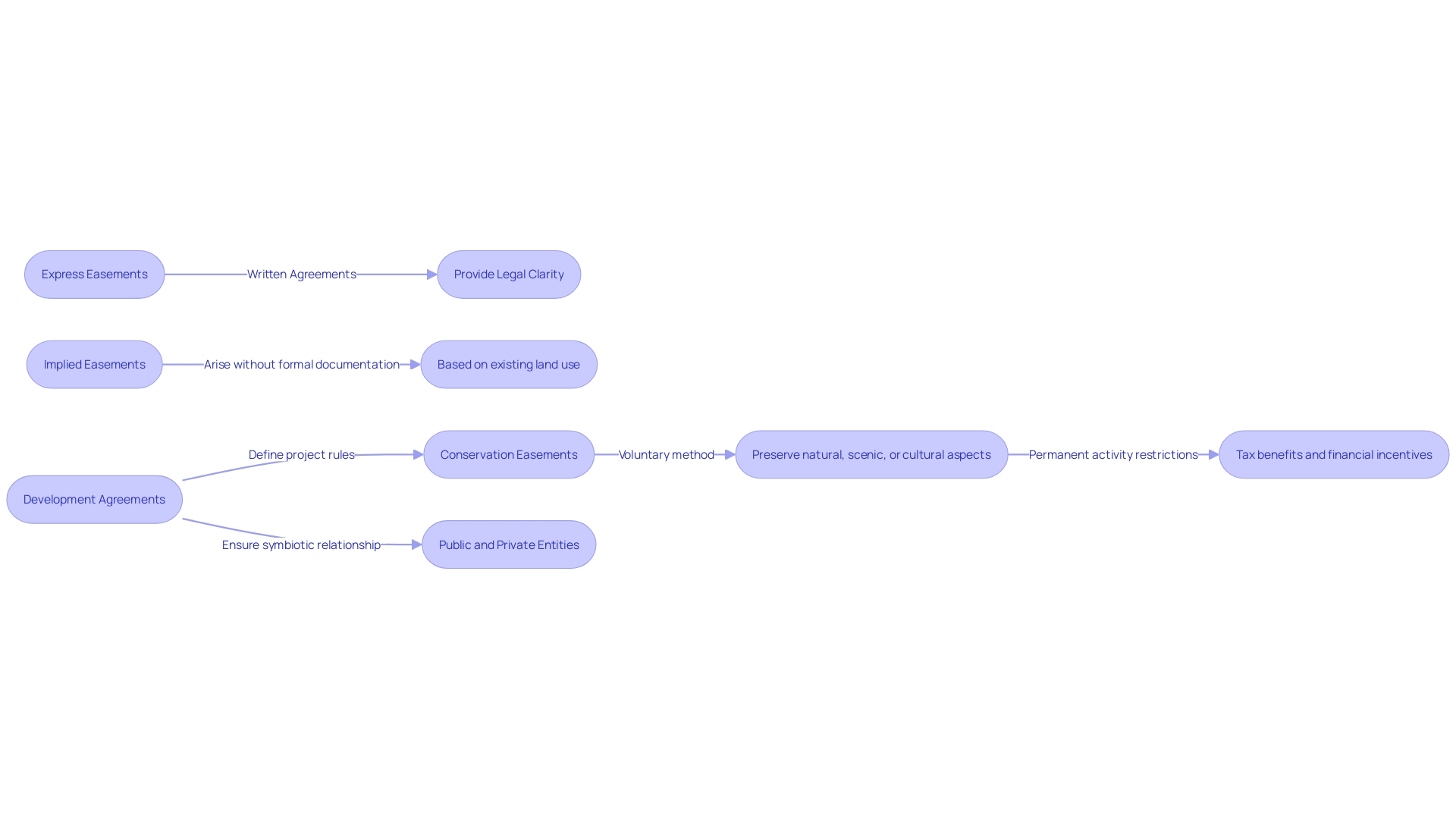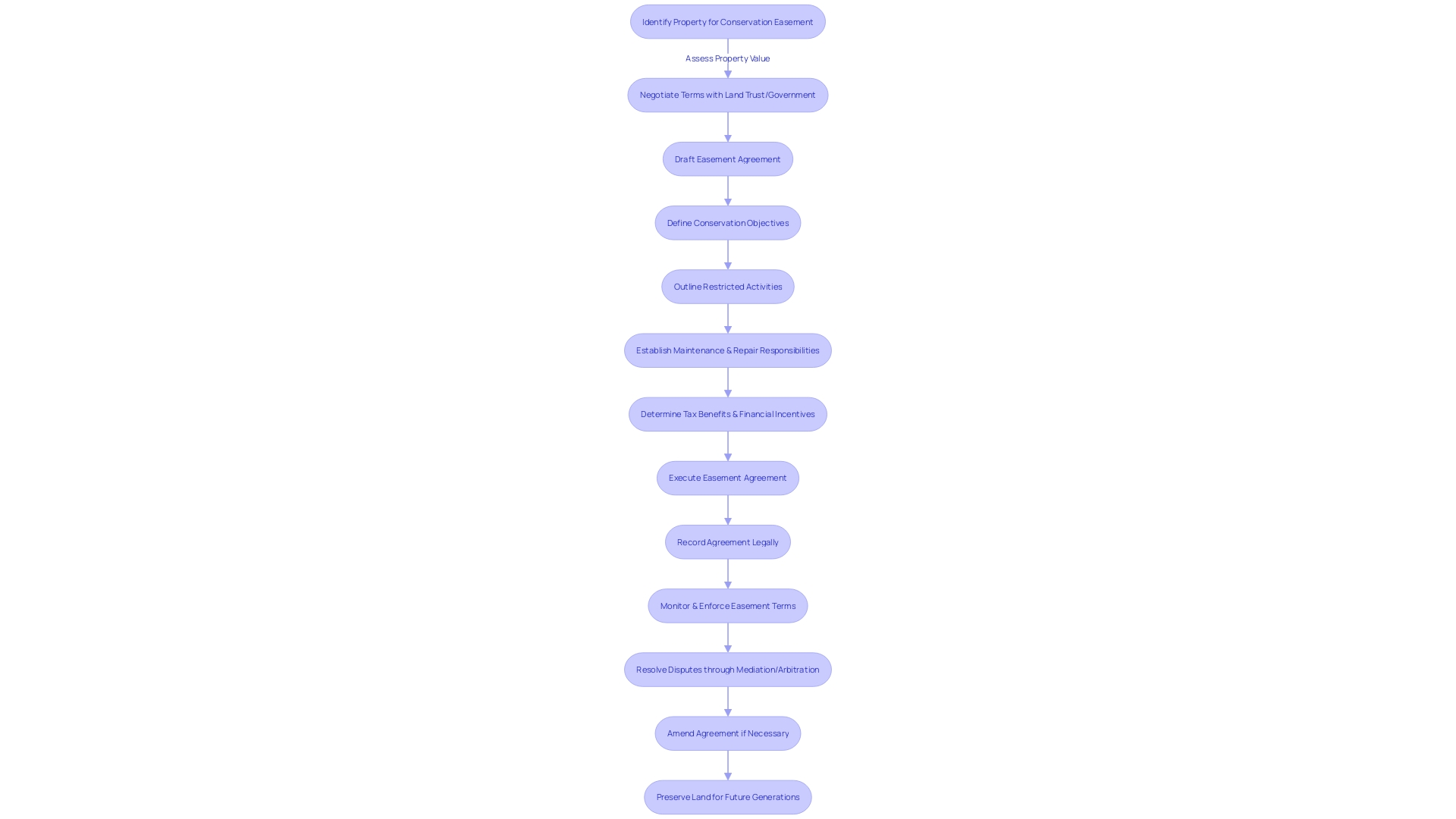Introduction
Easements, although often misunderstood, play a crucial role in land development and use. These legal instruments grant non-possessory interests in another's property, allowing specific actions or uses. From Easements Appurtenant that provide adjacent property owners with access to their neighbor's land, to Easements in Gross used by utility companies for maintaining infrastructure, different types of easements serve various purposes.
Additionally, easements by necessity and prescriptive easements arise out of specific circumstances or continued usage of land. An emerging application of easements is seen in the rise of conservation burial grounds, which operate under conservation easements to protect the land's natural state. Understanding the nuances of easement types is crucial for those involved in land acquisition and development, as these legal instruments shape property rights and development strategies.
In this article, we will explore the different types of easements, the process of creating easements, key components of easement agreements, and the development implications of easements. By delving into these topics, we aim to equip stakeholders with the knowledge to navigate the complex landscape of property development effectively.
Types of Easements
Easements represent a critical, yet often misunderstood, element in land development and use. An easement grants the holder a non-possessory interest in another's property, permitting specific uses or actions to be carried out. For instance, an Easement Appurtenant is intrinsically linked to the land, benefiting the owner of an adjacent property by allowing access to or over their neighbor's land, often for ingress and egress purposes.
Conversely, an Easement in Gross is personal to the holder and does not attach to the property itself; utility companies frequently utilize these to maintain infrastructure like power lines.
Another variant is the Easement by Necessity, typically arising when a landowner's property is landlocked and the only access is through another's land. This is established out of necessity rather than a mutual agreement. Additionally, a Prescriptive Easement emerges from the continued and overt use of land over a period, similar to the principles governing adverse possession but limited solely to usage rights.
A contemporary application of easements is seen in the rise of green burial practices. A Conservation Burial Ground, for instance, is a green cemetery that operates under a conservation easement or deed restriction, safeguarding the land's natural state in perpetuity. This aligns with the increasing interest in environmentally responsible burials, which as of 2023, has been considered by 60% of Americans, marking a significant shift from traditional burial norms.
Understanding the nuances of different easement types is essential for those involved in land acquisition and development. Whether for traditional use or innovative applications such as conservation burial grounds, these legal instruments shape the landscape of property rights and development strategies.
Creating Easements
Land easements, fundamental tools for property development, come in different types. Express easements are formalized through written agreements that define the scope and terms of the land use granted to a grantee by the grantor. The precision of these documents ensures clarity and legal standing for both parties.
Conversely, implied easements emerge from the existing use of land, suggesting an understanding between parties, even in the absence of formal documentation. A common example of an implied easement occurs when a landowner sells a section of their property but retains access to their remaining land via a road traversing the sold parcel.
In practice, developers engage in development agreements with local governments, defining the project's rules and obtaining public benefits. These agreements, when well-executed, create a symbiotic relationship between public and private entities, ensuring developments meet communal goals while providing certainty to developers. For instance, amidst market uncertainties like fluctuating interest rates and shifting commercial tenancies, development agreements offer stability by safeguarding against unforeseen regulatory changes.
This was evident in cases where development agreements have been instrumental in facilitating successful projects that align private development objectives with public interests, such as in Tashkent, Uzbekistan, where digitalization and improved land management were prioritized.
Furthermore, conservation easements represent a voluntary, yet legally binding, method for landowners to preserve their property's natural, scenic, or cultural aspects. These agreements, tailored to each property, restrict activities that could degrade its value, while potentially providing the owner with tax benefits. Such easements have safeguarded millions of acres, reflecting a commitment to intergenerational stewardship.
In summary, understanding the nuances of express and implied easements, along with the strategic use of development agreements and conservation easements, equips stakeholders with the means to navigate complex real estate landscapes effectively. The integration of these instruments into property development practices ensures not only the protection of interests but also the advancement of sustainable and beneficial land use.

Key Components of Easement Agreements
In crafting an easement agreement, it is vital to incorporate precise details to avert future misunderstandings and safeguard the interests of all concerned entities. Key elements to consider are:
-
Location and Description of Easements: Precise delineation of the easement's geographical parameters is essential. This can involve elaborate maps, surveys, or legal narratives to ensure the easement's boundaries are unmistakably defined, thereby preventing potential disputes.
-
Maintenance and Repairs: Clearly articulating maintenance duties within the agreement is imperative. This includes assigning accountability for routine upkeep, repair work, and the financial responsibilities associated.
-
Taxes and Consideration: The agreement must address any tax repercussions and outline any monetary compensation afforded to the grantor for bestowing the easement.
-
Remedies and Dispute Resolution: Including mechanisms for resolving disagreements pertinent to the easement, such as mediation or arbitration, can provide a structured approach to conflict resolution.
Case studies like the avigation easement at Rocky Mountain Metro Airport demonstrate the complexities that can arise when easement agreements intersect with evolving land use and community interests. Furthermore, tax and investment implications of easements, as discussed in recent court cases, underscore the importance of a well-structured agreement. While development agreements serve as a contract establishing development conditions, conservation easements preserve land's natural or cultural resources, often providing tax benefits to the landowner.
These multifaceted tools require careful consideration to balance public benefits and private interests and are pivotal in navigating today's volatile real estate market.

Development Implications of Easements
Understanding easements is essential for developers navigating the intricate landscape of land development. These legal agreements can have profound implications on property use and rights, influencing both public and private interests. Easements may impose limitations on the owner's ability to exclude others, potentially affecting future development plans.
For example, conservation easements, agreed upon between landowners and conservation entities, are designed to preserve land in its natural state, thereby restricting certain land uses and development. Such restrictions can be pivotal in ensuring the conservation of natural, scenic, or cultural resources.
In the realm of urban development, navigating the complexities of regulatory environments is crucial. As seen with the National Environmental Policy Act (NEPA) and state versions like the California Environmental Quality Act (CEQA), regulations intended to safeguard environmental impacts can inadvertently lead to delays and increased costs for development projects. These laws, while promoting transparency, are sometimes leveraged to prolong the development process, adding years of delay through mandated compliance measures.
The case of Bruce's Beach in California highlights the historical challenges and legal disputes over land rights that can arise, particularly when eminent domain comes into play. This reflects the potential for land acquisition processes to become contentious, and underscores the importance of thorough legal understanding and strategic planning.
Moreover, the commercial real estate market is subject to volatility, with factors such as fluctuating interest rates and changing retail landscapes presenting challenges. Development agreements emerge as a strategic tool in such uncertain times, providing a measure of certainty against shifting political and regulatory landscapes. These agreements outline the conditions and expectations for development projects, balancing public benefits with the developer's objectives.
The economic and fiscal impacts of development projects are also significant considerations. Reports analyzing prospective job creation, business activity, and tax revenue underscore the potential for both positive and negative outcomes. The analysis of the Freestone Club development, for instance, reflects the intricate balance of projected benefits against the realities of development and the need for accurate, realistic planning.
For property owners and developers, being well-informed and seeking professional advice is vital. Legal and land development experts can offer essential guidance to navigate the potential challenges and optimize the benefits of development agreements. Ultimately, achieving a harmonious balance between development goals and legal constraints is key to successful land development projects.
Conclusion
Easements are crucial in land development, granting non-possessory interests for specific actions or uses. Understanding easement types is vital for land acquisition and development, shaping property rights and strategies.
Express and implied easements are common, formalized through written agreements or emerging from existing land use. Development agreements with local governments create a symbiotic relationship, ensuring communal goals and stability for developers. Conservation easements preserve natural, scenic, or cultural aspects voluntarily.
Precise details in easement agreements prevent misunderstandings and safeguard interests. Key components include location delineation, maintenance responsibilities, taxes, compensation, and dispute resolution mechanisms.
Easements profoundly impact property use and rights, influencing public and private interests. Conservation easements restrict uses and development to preserve land. Navigating regulations is crucial, as environmental laws can cause delays and increased costs.
Legal understanding and strategic planning balance development goals with constraints.
In conclusion, understanding easements is essential for successful land development. By comprehending types, creation process, agreement components, and development implications, stakeholders can navigate the complex landscape effectively.




